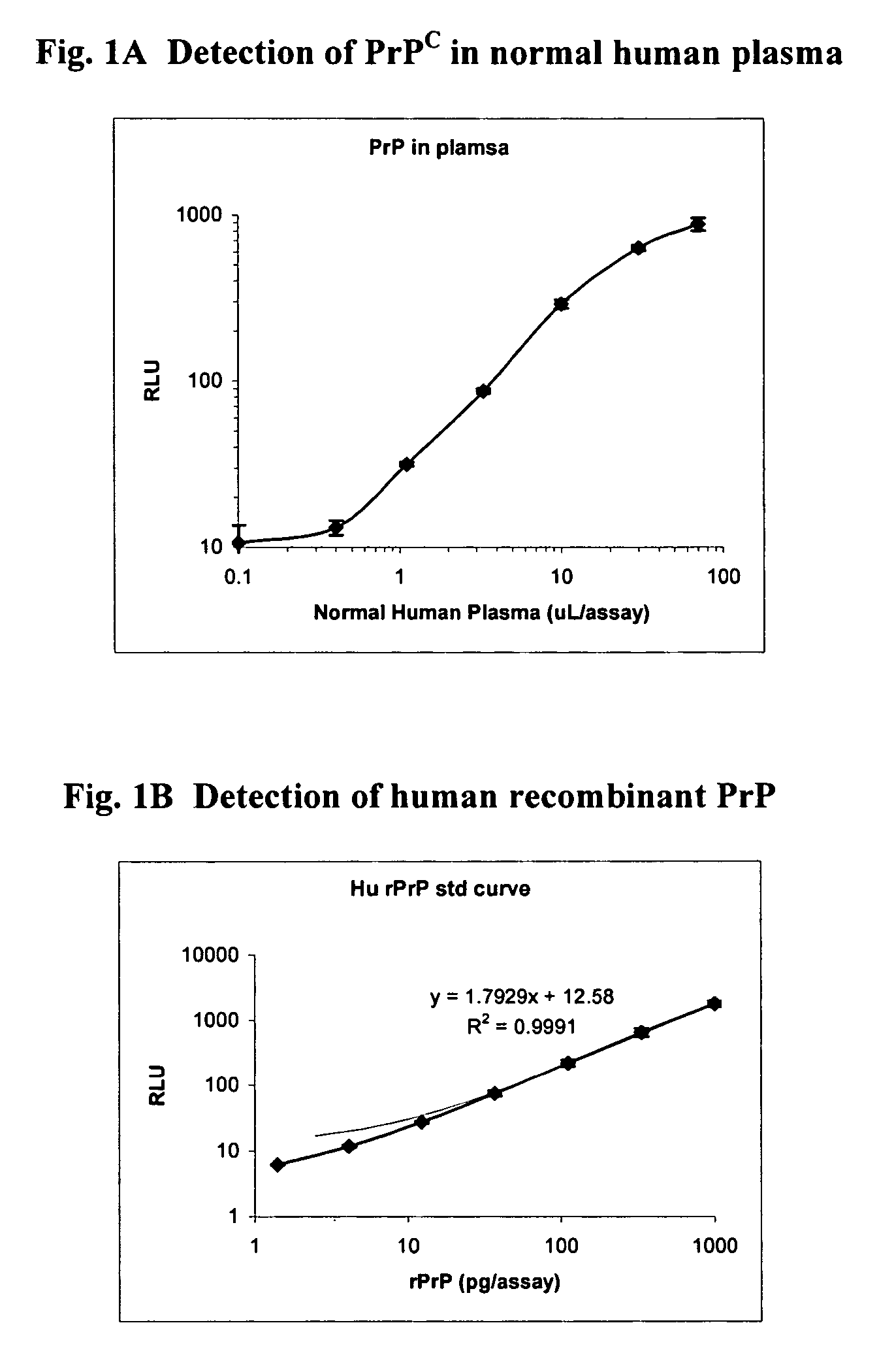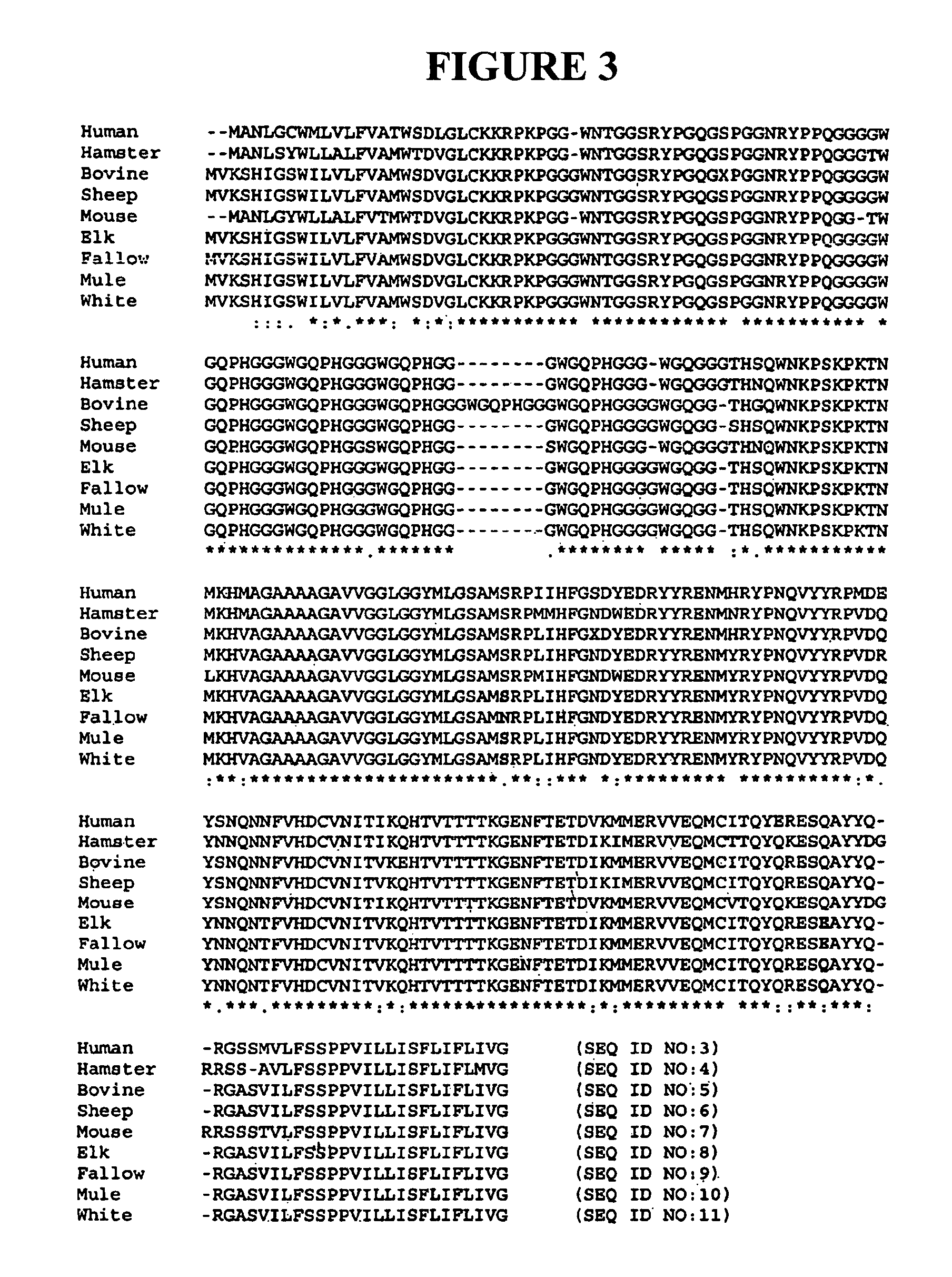Prion-specific peptoid reagents
a technology of peptoid reagents and prion, which is applied in the field of prion-specific peptoid reagents, can solve the problems of affecting the survival of subjects, the inability to definitively diagnose and treat amyloid-containing conditions before the subject's death, and the inability to detect conformational disease proteins in living subjects. it can solve the problem of preventing prion-related infection in animals, preventing prion-related
- Summary
- Abstract
- Description
- Claims
- Application Information
AI Technical Summary
Benefits of technology
Problems solved by technology
Method used
Image
Examples
example 1
Peptoid Region Sequences
[0376]Table 1 lists example peptoid regions (amino to carboxy directed) suitable for preparing peptoid reagents of the present invention. Table 2 provides a key to the abbreviations used in Table 1. Table 3 provides the relevant structures of each of the sequences. Peptoid reagents containing the sequences of Table 1 were tested for preferential binding to PrPSc, according to the assays described herein. Preparations of the specific reagents are described hereinbelow.
[0377]
TABLE 1Representative peptoid regions for peptoidreagents of the invention.SEQPeptoid Region SequenceID NO:Nab-Nab-Nab-Nab-Nab229Nab-Nab-Ngb-Nspe-Nab-Nspe230Nae-Nmpe-Nmpe-Nae-Nmpe-Nmpe-Nae-Nmpe-Nmpe231Nme-Ntrp-Nme-Nab-Nspe-Nhye-Nab-Nspe-Nhye-Nme232Nspe-Nab-Nspe-Nab-Nspe-Nspe-Nab-Nspe-Nab-233Nspe-NspeNbn-Nab-Nbn-Nab-Nbn-Nbn-Nab-Nbn-Nab-Nbn-Nbn234Nme-Nab-Nme-Nab-Nnm-Nme-Nab-Nnm-Nab-Nme-Nme235Nme-Nab-Nme-Nab-Nme-Nme-Nab-Nme-Nab-Nme-Nme236Nab-Nab-Nab-Nspe-Nab-Nspe237Nab-Nspe-Nab-Nab-Nspe-Nab238...
example 2
Peptoid Reagents
[0380]The following peptoid reagents were prepared using synthetic methods for preparation of peptoid molecules containing N-substituted glycine residues such as the procedures disclosed in U.S. Pat. Nos. 5,811,387, 5,831,005, 5,877,278, 5,977,301 and 6,033,631, as well as Simon et al. (1992) Proc. Natl. Acad. Sci. USA 89: 9367, each of which is incorporated herein by reference in its entirety, and using the protocol described in Example 5. Each of the below reagents was tested for binding affinity for a prion protein according to the assays described herein.
Peptoid Reagent I
[0381]The below peptoid reagent comprises SEQ ID NO: 229.
[0382]
Calculated Mass: 1054.42; Observed Mass: 1054.2. All observed mass measurements were measured on a Waters (Milford, Mass.) Micromass ZQ LC / MS System.
Peptoid Reagent II
[0383]The below peptoid reagent comprises SEQ ID NO: 230.
[0384]
Calculated Mass: 1290.70; Observed Mass: 1290.8.
Peptoid Reagent III
[0385]The below peptoid reagent compris...
example 3
Binding Assays
Pull-Down Assay
[0407]Peptoid reagents of Example 2 were tested for their ability to specifically bind to pathogenic prion proteins using a magnetic bead pull down assay. For this assay, peptoid reagents were attached to magnetic beads in one of two ways: 1) the peptoid reagents were labeled with biotin, which allowed attachment to streptavidin coated magnetic beads or 2) peptoids were covalently linked to magnetic beads through a thiol propionic acid. The mode of attachment of the peptoid reagent to the beads had little effect on the binding activity of the peptoid reagent; however, when the peptoid reagents were covalently attached to the beads, less background interference from plasma samples used as diluent was observed. The magnetic beads were obtained from Dynal (Brown Deer, Wis.). Typically, ten microliters (10 μl) of Streptavidin M-280 Dynabeads® (cat # 112.05) were used for single pull-down reaction using biotinylated peptoid reagent.
[0408]Human brain homogenat...
PUM
| Property | Measurement | Unit |
|---|---|---|
| pH | aaaaa | aaaaa |
| pH | aaaaa | aaaaa |
| pH | aaaaa | aaaaa |
Abstract
Description
Claims
Application Information
 Login to View More
Login to View More - R&D
- Intellectual Property
- Life Sciences
- Materials
- Tech Scout
- Unparalleled Data Quality
- Higher Quality Content
- 60% Fewer Hallucinations
Browse by: Latest US Patents, China's latest patents, Technical Efficacy Thesaurus, Application Domain, Technology Topic, Popular Technical Reports.
© 2025 PatSnap. All rights reserved.Legal|Privacy policy|Modern Slavery Act Transparency Statement|Sitemap|About US| Contact US: help@patsnap.com



